By Jeffrey A. Rendall
CLIFTON, VA -- Golf traditionalists are minimalists (how's that for a tongue twister?). They subscribe to the "less is more" theory.
When you think about it, minimalism makes sense. If you want an intimate wedding, you should only invite a few people. If you want higher quality products, you're better off having a few good ones rather than a peck of junk. And if you want to find a traditional golf experience, you probably won't find it where they've moved millions of cubic yards of earth to construct a golf course.
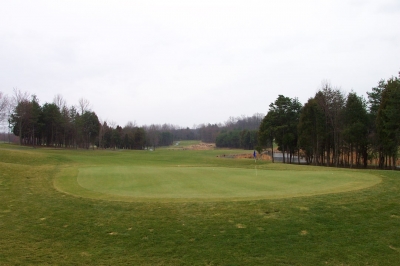 |
The most traditional golf designs just seem to fit the land they inhabit (i.e., 'minimalist' in nature) -- and that goes way back to the birthplace of the game in Scotland. It had to be that way, because golf's forefathers lacked the modern earth-moving equipment necessary to shape the countryside. That's probably the reason why folks first played golf in livestock grazing pastures. There, the most serious obstacles were probably the organic paddies -- not yawning sand bunkers or gleaming lakes and waterfalls.
But even when golf ventured into the industrial age, and earth-moving equipment was powered by internal-combustion engines, some of the traditionalists continued observing the ancient 'minimalist' philosophies. Architects like Donald Ross and A.W. Tillinghast took what the land provided, and molded their golf courses into the landscape. If you ever look at one of the masters' courses, it looks like God 'placed' it there (and no, we're not promoting golf architects to deity status).
Traditionalists lay out courses on land like chocolate syrup on vanilla ice cream -- they just seem to belong there.
For those seeking the minimalist experience, try the Twin Lakes golf facility in the upscale neighborhood of Clifton in Fairfax County. Twin Lakes features two golf courses at this county owned club -- the Lakes course, which opened in 1967, and the Oaks course, which opened in 1998. For the purposes of this review, we'll concentrate on the newer Oaks course.
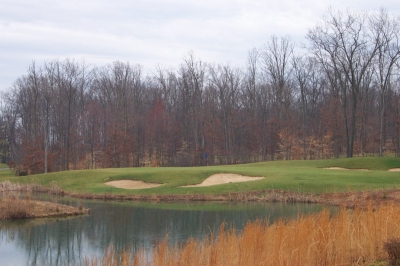 |
Peter Furey, Twin Lakes' Manager, says the goal when building the course was making sure it fit the existing land: "The Fairfax County Park Authority had this extra piece of land (formerly the Lewis farm, complete with apple orchards and cows grazing) surrounding the older Lakes course, and wanted to put another golf course here. When the Park Authority searched for a golf architect, they decided on Denis Griffiths because his past work proved he does a pretty solid job of routing golf courses that just seem to lay nicely with the land. That's exactly what they wanted for this facility."
In other words, Griffiths' minimalist philosophies were a good match. When he saw the property, it was apparently love at first sight. Furey continues, "Griffiths saw the land, with its stately oaks and gentle undulations and said it was just about the perfect site for a golf course. All the oaks were about the same age, so he wasn't really constrained in laying out the course, either -- he didn't have to preserve one grove vis-à-vis another."
Again, Griffiths saw that less is more. He moved hardly any dirt to build this course, which was good for the natural environment as well as the county's bottom line. Or, as Furey points out, the course just seems to 'lay' nicely.
That's the impression you'll get when playing the Oaks course. Like its upscale golf course brethren, it offers pristine tree-lined fairways, some water and wetlands, lots of undulations and some pretty solid conditioning for a course in its price range. All for a very "publicly-owned and -operated" price.
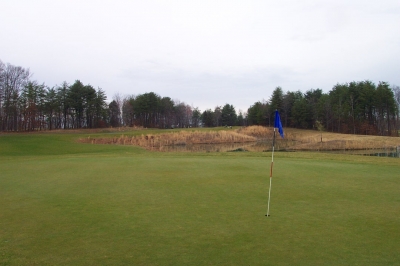 |
In fairness to those courses in the higher tax bracket, some of the things you'll find when you pay more aren't available at Twin Lakes -- but the course itself rates high in the "pure golf" category.
And following the traditions of golf, is very walkable.
The Oaks stretches to 6700 yards from the back tees and plays to a slope of 139. As the name would indicate, there's certainly no shortage of trees on the course, with most holes framed on both sides by a deciduous gallery (some evergreens too). Despite the heavily wooded nature, the trees surprisingly don't come into play as much as one would expect.
Furey elaborates: "The course winds in and out of stands of trees, but the landing areas are really quite wide. We're also continuing to remove undergrowth from the forested areas, so even if you hit one in there, chances are you'll still have a shot at getting out."
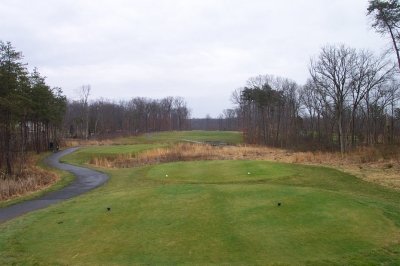 |
There also aren't a great number of forced carries, but for those that do exist, they're significant. Case in point is the view from the second tee -- it's about as intimidating as you'll ever see. Furey says it's 'only' 192 yards to clear the lake from the back tees, but it looks farther. If the wind's against players on this hole, that lake probably overflows with golf balls. One nice thing--there's often the 'next fairway' option if you miss tee shots, too (on a good many holes).
The Oaks' greens are large and relatively flat. Putts have subtle breaks and the speeds aren't lightning fast. Greenside bunkering is adequate but not overpowering.
Furey says playability's one of their ultimate goals: "Like most courses, we wanted something that's challenging to the low handicappers, yet fair enough for most of our clientele -- the mid-to-high handicappers. I think we've achieved that through our layout -- but also from having large tee boxes, where we can move the marker positions around frequently, as well as having large enough putting surfaces to provide for many pin positions. The variety's built into the layout -- with holes of different lengths, downhill shots, uphill shots, etc ... But with the way we set up the golf course with the tees and greens, you'll play a different course every time."
Some of the tee boxes did remind me of a Robert Trent Jones-like "runway" styled box. There could easily be variations of 15 or 20 yards depending on placement of the markers. It's a thoughtful way to vary the layout without going to unnatural lengths.
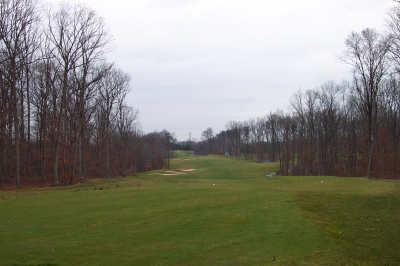 |
Looking at the course, don't be discouraged if you score high on the first two holes -- they're two of the toughest starting holes you'll find anywhere.
The first is a 546 yard par five, playing downhill from the tee. The tricky part's in deciding whether to lay up or try and clear a 'natural' area that runs through what would be the second shot landing area (there's also a sharp dogleg left to the green). If you lay up short, it'll leave a tricky uphill third shot to a green protected on both sides by sand.
As mentioned above, the second hole's got a difficult tee shot. But the work doesn't end with clearing the lake. Not only does the hole measure 468 yards from the back, the second shot's uphill. It's too short for a par five, too long for a par four. Call it a par four and a half.
The balance of the front nine is easier, highlighted by the fifth hole, a picturesque 184 yard par three over water to the front and left. Bunkers guard the somewhat narrow green, but there's plenty of room to miss right if you don't have confidence in your club selection.
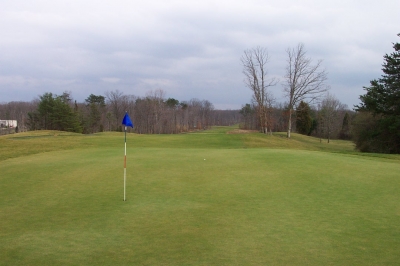 |
The Oaks' relatively high slope rating is probably due to a murderer's row of tough holes on the back nine, starting with number 10. 437 yards in length, the tee shot's downhill to a fairway sloping left to right. Somewhat hidden from the tee is a lake that juts into the fairway from the right, which makes keeping the ball left of it all the more difficult because of the slope.
The 'row' starts with thirteen, a 447 yard par four. A mild carry off the tee, you'll also have to stay clear of the encroaching tree-lines on both sides. Chances are you'll still leave a long-iron or fairway-wood into the green -- but there's a lot of room to miss on either side should you fail to hit it perfectly straight.
Fifteen's a bear of a par five at 584 yards (and slightly uphill). Much of the difficulty of the previous hole confronts you again on this definite three-shotter. Take par and run.
Just when you're ready for a break, sixteen's a 235 yard par five. Right about now you're thinking this must be a US Open set-up, but the green's large and very little trouble threatens on either side of the green if you miss. And there's ample opportunity to run it up, too.
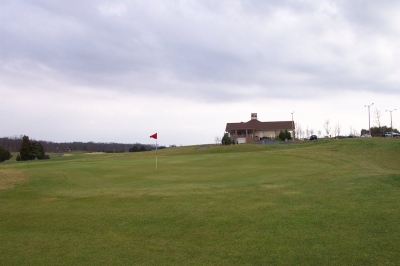 |
Eighteen's a nice closing hole. 535 yards of par five, watch for the water on the right side of the tee landing area (it slopes down towards it, too), and trees on the left. If you've got a good tee ball, this green could be reached in two. Nice to have a possible birdie try to finish up after weathering some of those tougher tests a few holes previous.
Overall, Twin Lakes' Oaks course is a pretty nice course at an extremely reasonable price for what you get. You'll pay less and get more -- minimalism at its finest.
Details:
The Oaks Course at Twin Lakes
6201 Union Mill Road
Clifton, VA 20124
Phone: (703) 631-9099
Tee Times: (877) 776-3272
FAX: (703) 803-6239
Website: www.co.fairfax.va.us/parks/golf.htm
Manager: Peter Furey
Course Architect: Denis Grifiths
| Tees | Yardage/Slope |
| Blue | 6700/139 |
| White | 6316/135 |
| Gold | 5614/125/123 (Women) |
| Red | 4686/109 |
Rates (In-Season):
Mon-Thurs: $31 (walking); Fri-Sun: $39 (walking).
Carts are $13 a player. Nine-hole rates are also available -- call for availability.
| Related Links | Comments on this article? | |
|
Maryland National Golf Club Hollow Creek Golf Club Rocky Gap Resort PB Dye Golf Club in Ijamsville Whiskey Creek Golf Club |
E-mail Jeff Rendall, Editor: jrendall@golftheunitedstates.com |












